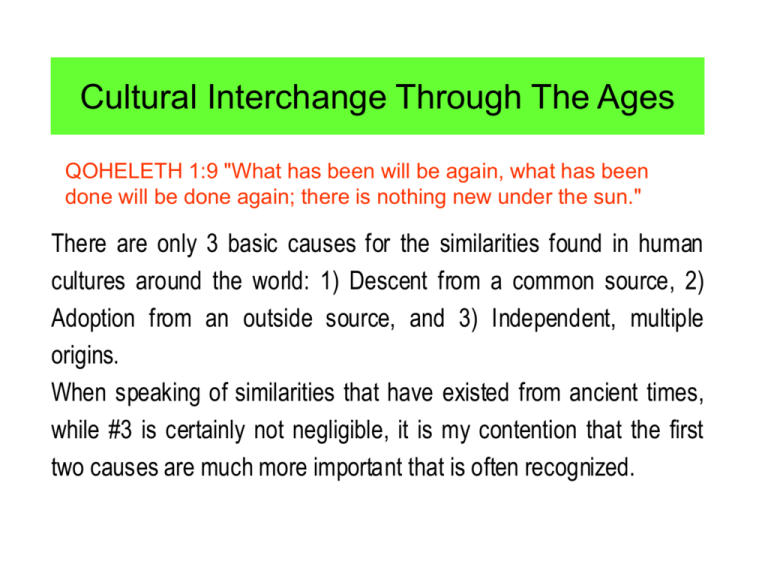Powerpoint
advertisement

Cultural Interchange Through The Ages QOHELETH 1:9 "What has been will be again, what has been done will be done again; there is nothing new under the sun." There are only 3 basic causes for the similarities found in human cultures around the world: 1) Descent from a common source, 2) Adoption from an outside source, and 3) Independent, multiple origins. When speaking of similarities that have existed from ancient times, while #3 is certainly not negligible, it is my contention that the first two causes are much more important that is often recognized. Example of #1: Ancient Flood Myths (http://ancienthistory.about.com/library/bl/bl_myth_flood.htm) A wide variety of ancient cultures have their own versions of a Great Flood; many of these tales contain the following similarities: • Humans are guilty of transgression. • God (or gods) send a flood as punishment. • Instructions are sent to an individual to build a craft. • The instructions include ensuring the survival of all species. • The flood destroys the old race. After the flood, a new, less sinful race emerges to repopulate the earth. • A summary of a couple of examples that show amazing similarity to the story of Noah: Aztec In the Valley of Mexico there lived a pious man named Tapi. The Creator told him to build a boat to live in, to take his wife and a pair of every animal that existed. Neighbors thought he was crazy. As soon as he finished, it began to rain. The valley flooded; men and animals went to mountains, but they were submerged. The rain ended, waters receded, etc. Tapi realized that the floodwaters had receded after having sent a dove that did not return. Tapi rejoiced. Hawaiian A Hawaiian legend tells of a flood in which all beings were killed except for Nuu and his family who repopulated the earth when their boat landed on top of Mauna Kea. China While specific flood legends exist in China, I want to briefly look at some circumstantial evidence in the origin of Chinese characters. Ship 船 "Eight 'mouths' on a boat". Flood 洪 Two primary ways of explaining these similarities: Coincidence. Practically every culture faces disastrous floods at one time or another and these are explained by mythology. Common source. DNA studies conclude that all humans emerged from a common ancestral pair on the order of 50,000 years ago. If such a flood took place in prehistory, then it's logical that its distant memory would be preserved in ancient stories. Example of #2: The Spread of Christian Concepts Along "The Silk Road" As Far As Japan Premise: All religious systems have borrowed and adapted concepts and traditions from others. A Few Pertinent Facts: St. Thomas in South India by 52 A.D. Recent discovery of Christian artifacts in tombs near Shanghai dating from 86 A.D. The "Assyrian Church of the East" (Nestorians) well established in China during T'ang Dynasty (618-907 AD). "Jingjiao" ( 景 教 Luminous Teachings, "Keikyo" in Japanese pronunciation) entered Japan in a big way with mass immigration of the Hata clan. These people had an enormous influence in ancient Japan. Japan is thought of as having been a Shinto and Buddhist culture from ancient times. Christianity is said to have first entered Japan in 1549 with Xavier. But this standard view needs to be modified. It is true that Western Christianity first came with Xavier, but "Keikyo" (="Nestorianism") was here long before, leaving its legacy in the form of many adopted ideas. Important Buddhist figures such as Honen, Kuukai and Shinran were exposed to Keikyo teachings in China and clearly adopted important concepts into their own thinking. The Shingon sect founded by Kuukai readily admits (and even takes pride in) having its roots in Keikyo. Later generations turned Prince Shotoku into a messianic figure that clearly paralleled the stories of Christ. Historic Shinto shrines and Buddhist temples connected with the Hata clan still contain numerous clues pointing to their Keikyo origins. Conclusion: Many aspects of Japanese Buddhism were adopted and adapted from Keikyo Christianity. This is a clear example of how concepts and forms that show similarities and that are usually thought of as having arisen independently have actually been borrowed. The Christ motif of a savior entering human history from outside appears to have found its way into many stories. For instance, "Momo Taro", an ancient Japanese fairy tale of a boy that is born from a giant peach that floats up to a farmhouse. He is raised by the farmer and becomes a kind of savior who vanquishes evil with his power. In modern terms, it's very much like the story of "Superman". The common motif would seem to have been derived from the Christ story.







